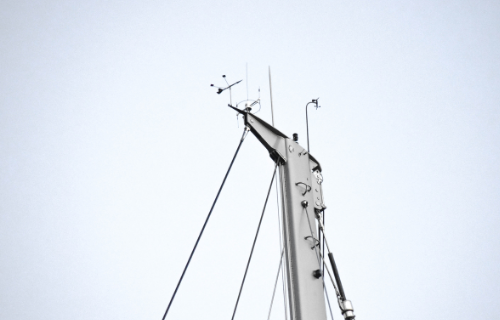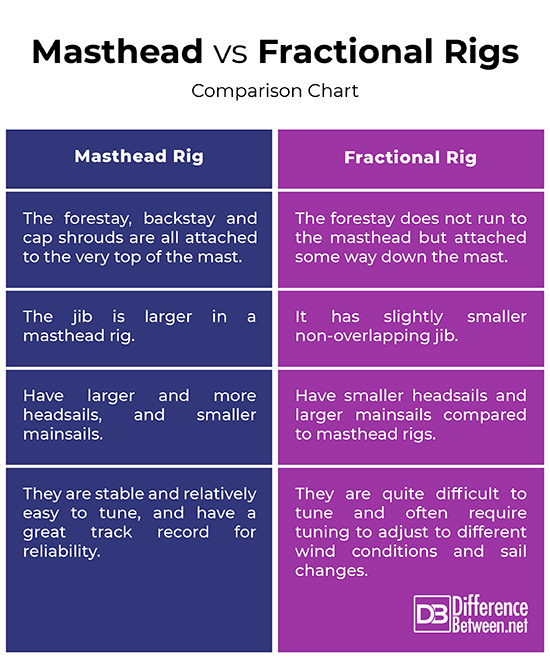Difference Between Masthead and Fractional Rig
The most widely used rig in the world is probably the Bermudan rig, which can be basically split into two main groups: the masthead rig and the fractional rig. Well, rigging is simply the transmission system whose job is to transmit to the hull the power harnessed by the sails. It’s simply your boat’s engine which consists of the mast, spreaders, stays and shrouds with deck and mast fittings.

What is a Masthead Rig?
A masthead rig is more common on cruising sailboats and is considered a more traditional way to rig a boat. A masthead rig on a sailing vessel has the forestay, backstay and cap shrouds, all attached to the very top of the mast (the masthead). This allows the headsails to reach the same vertical height as the mainsail. The masthead rig has larger and more headsails, and a relatively smaller mainsail compared to fractional rigs. The masthead rig has considerable stiffness and adjustment to the prevailing weather conditions can only be achieved by means of sail selection. This is stable and relatively easy to tune. One of the best things about a masthead rig is that the jib is larger. Masthead rigs are simple and have a great track record for reliability.

What is a Fractional Rig?
A fractional rig typically has a larger mainsail and smaller headsail than a masthead rig. It allows the mast to bend more easily, making the headsails handier. Being smaller, they can be reefed later, and so will set better in a blow. They require smaller winches; sheet loads are less, so they are safer. Some cruisers are designed with a fractional rig, in which the forestay does not run to the masthead but attaches some way down the mast. Fractional rigs are common amongst racing sailboats and sailing dinghies. The need for a runner is even greater in fractional rigs. The upper runner has the same function as the backstay in a masthead rig; to hold the mast up. However, they are quite difficult to tune and often require tuning to adjust to different wind conditions and sail changes.
Difference between Masthead and Fractional Rig
Design
– A masthead rig can be considered a more traditional way to rig a boat. A masthead rig on a sailing vessel has the forestay, backstay and cap shrouds, all attached to the very top of the mast (the masthead). In a fractional rig, the forestay does not run to the masthead but attached some way down the mast. The hounds of the mast are moved up somewhat, but the forestay remains well below the masthead.
Jib
– A jib is a triangular headsail borne in front of the mast to allow for more sail area and it also has something to do with the aerodynamics of the sails. It mounts on the forestay between the bow and the masthead. The jib is larger in a masthead rig and since there’s no mast in front of it to cause turbulent airflow, it’s considered more efficient. The jib on a fractional rig does not reach all the way up to the mast and it has slightly smaller non-overlapping jib. This configuration is optimized for upwind sailing efficiency.
Headsail
– The masthead rigs have larger and more headsails, and smaller mainsails, providing the best rig security available. The standard masthead configuration provides a secure and balanced geometry which helps resist the loads imposed on the mast. Fractional rigs, on the other hand, have smaller headsails and larger mainsails compared to masthead rigs, making them easier for a small crew to handle. Being smaller, they can be reefed later and so will set better in a blow.
Tuning
– Masthead rigs are stable and relatively easy to tune, and they are simple and have a great track record for reliability. This configuration provides a secure and balanced geometry to resist the loads on the mast. Fractional rigs, on the other hand, are quite difficult to tune and often require tuning to adjust to different wind conditions and sail changes.
Masthead vs. Fractional Rigs: Comparison Chart

Summary
The masthead rigs work well upwind and reaching, but as the boats bear further off the wind, the smaller mainsail becomes an increasing drawback. The relatively modest mainsail makes it easy to handle. Also, they are stable and easy to tune, and they have a great track record for reliability. Fractional rigs have the advantage that their headsails are far more handier. The mainsails are usually bigger than their masthead counterparts. Mainsails are easier to deal with than genoas because the foot is controlled by the boom. They reef more efficiently too. Fractional rigs are often used on performance-oriented cruisers or cruiser-racers.
Why is fractional rig better?
The mainsails are usually bigger than their masthead sisters, and these are easier to deal with than genoas because the foot is controlled by the boom. It allows the mast to bend more easily, which is great when sailing upwind.
What is a masthead truck?
It’s a small wooden cap on a flag-staff or mast-head with holes or sheaves for halyards. A masthead truck is also fitted to receive the spindle of the lightning rod.
How do you sail a fractional rig?
The forestay is attached some way down the mast about 1/8 and 1/4 of the length of the mast lower down. The jib is then rigged to the forestay. The section between the two stays function as a lever which can effectively bend the mast to tune the sails.
What is a masthead ketch?
It is a two-masted sailboat, the mainmast of which is taller than the aft-mast or mizzen mast, typically in a boat 40-foot size or bigger.
- Difference Between Caucus and Primary - June 18, 2024
- Difference Between PPO and POS - May 30, 2024
- Difference Between RFID and NFC - May 28, 2024
Search DifferenceBetween.net :
Leave a Response
References :
[0]Cunliffe, Tom. The Complete Ocean Skipper: Deep-water Voyaging, Navigation and Yacht Management. London, United Kingdom: Bloomsbury Publishing, 2016. Print
[1]Dedekam, Ivar. Sail and Rig Tuning. West Sussex, United Kingdom: Fernhurst Books, 2001. Print
[2]Fabbroni, Danilo. Rigging: Rig Your Boat Right for Racing or Cruising. West Sussex, United Kingdom: Fernhurst Books, 2008. Print
